Surveillance and Disaster Planning: Simulation Reflection Report
VerifiedAdded on 2023/06/04
|14
|3443
|214
Report
AI Summary
This report provides a reflective analysis of a disaster simulation involving a car crash in a shopping mall, resulting in multiple casualties. The report details the emergency response, highlighting both effective actions and areas for improvement in the paramedic team's approach. It discusses the chall...

0Running Head: SURVEILLANCE AND DISASTER PLANNING
Surveillance and Disaster Planning
Surveillance and Disaster Planning
Paraphrase This Document
Need a fresh take? Get an instant paraphrase of this document with our AI Paraphraser
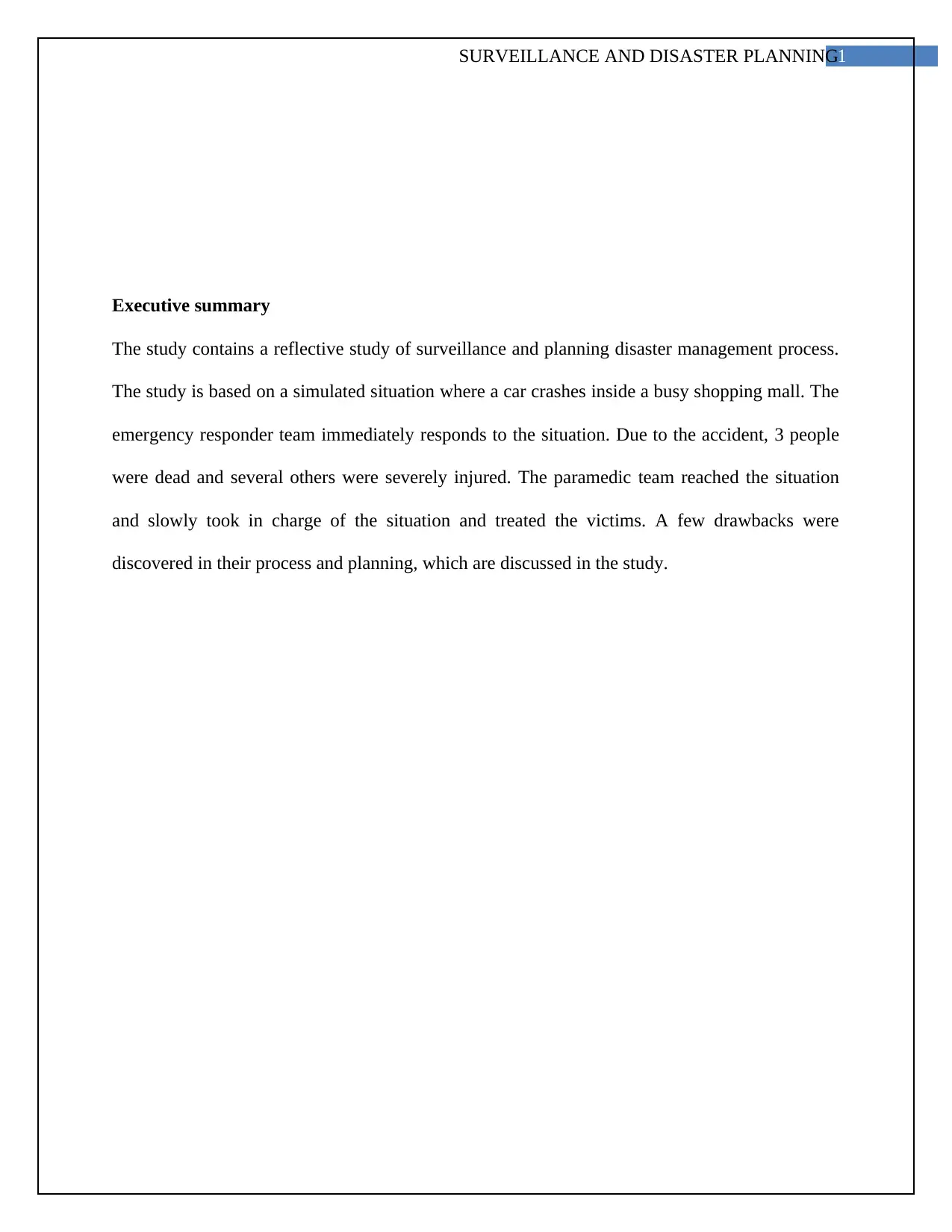
1SURVEILLANCE AND DISASTER PLANNING
Executive summary
The study contains a reflective study of surveillance and planning disaster management process.
The study is based on a simulated situation where a car crashes inside a busy shopping mall. The
emergency responder team immediately responds to the situation. Due to the accident, 3 people
were dead and several others were severely injured. The paramedic team reached the situation
and slowly took in charge of the situation and treated the victims. A few drawbacks were
discovered in their process and planning, which are discussed in the study.
Executive summary
The study contains a reflective study of surveillance and planning disaster management process.
The study is based on a simulated situation where a car crashes inside a busy shopping mall. The
emergency responder team immediately responds to the situation. Due to the accident, 3 people
were dead and several others were severely injured. The paramedic team reached the situation
and slowly took in charge of the situation and treated the victims. A few drawbacks were
discovered in their process and planning, which are discussed in the study.
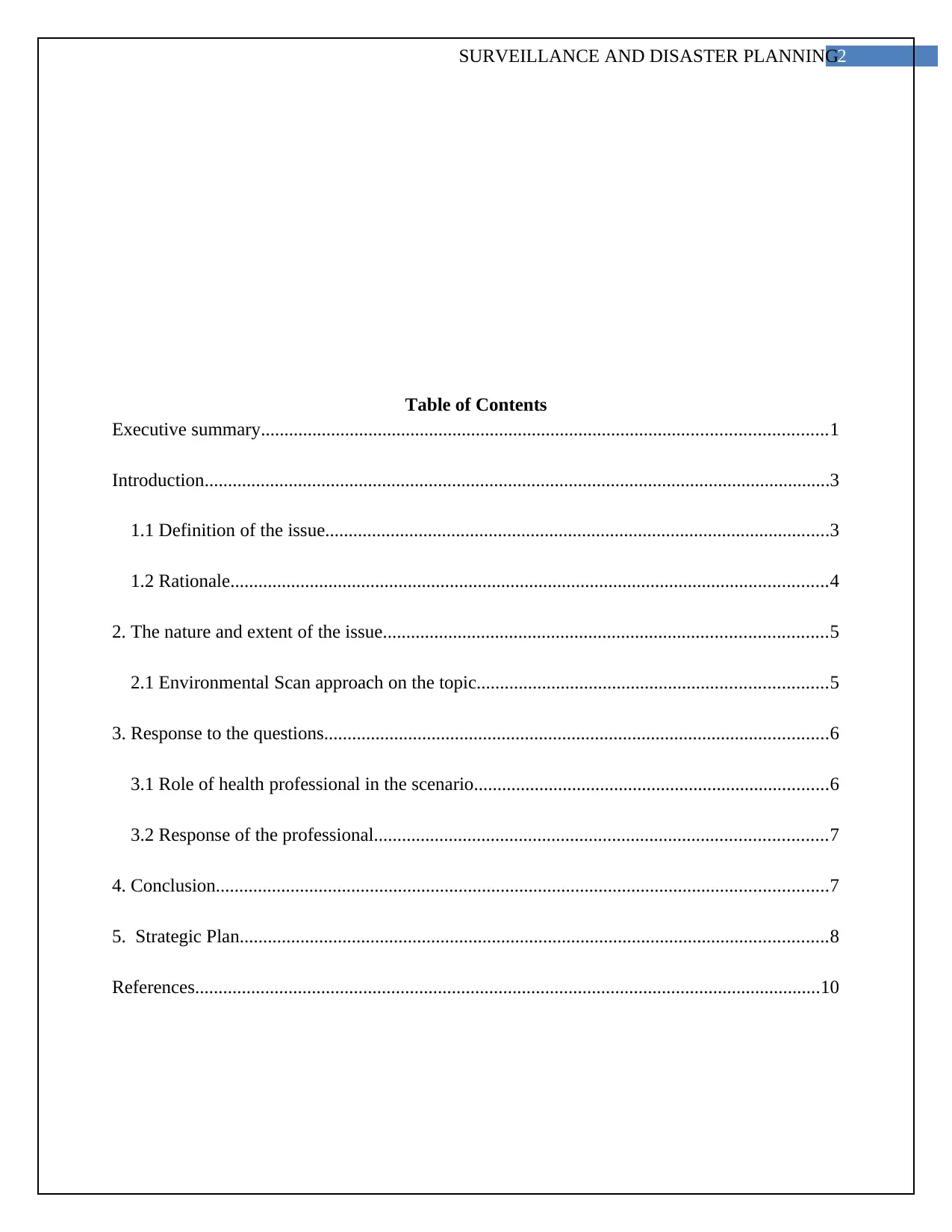
2SURVEILLANCE AND DISASTER PLANNING
Table of Contents
Executive summary.........................................................................................................................1
Introduction......................................................................................................................................3
1.1 Definition of the issue............................................................................................................3
1.2 Rationale................................................................................................................................4
2. The nature and extent of the issue...............................................................................................5
2.1 Environmental Scan approach on the topic...........................................................................5
3. Response to the questions............................................................................................................6
3.1 Role of health professional in the scenario............................................................................6
3.2 Response of the professional.................................................................................................7
4. Conclusion...................................................................................................................................7
5. Strategic Plan..............................................................................................................................8
References......................................................................................................................................10
Table of Contents
Executive summary.........................................................................................................................1
Introduction......................................................................................................................................3
1.1 Definition of the issue............................................................................................................3
1.2 Rationale................................................................................................................................4
2. The nature and extent of the issue...............................................................................................5
2.1 Environmental Scan approach on the topic...........................................................................5
3. Response to the questions............................................................................................................6
3.1 Role of health professional in the scenario............................................................................6
3.2 Response of the professional.................................................................................................7
4. Conclusion...................................................................................................................................7
5. Strategic Plan..............................................................................................................................8
References......................................................................................................................................10
⊘ This is a preview!⊘
Do you want full access?
Subscribe today to unlock all pages.

Trusted by 1+ million students worldwide
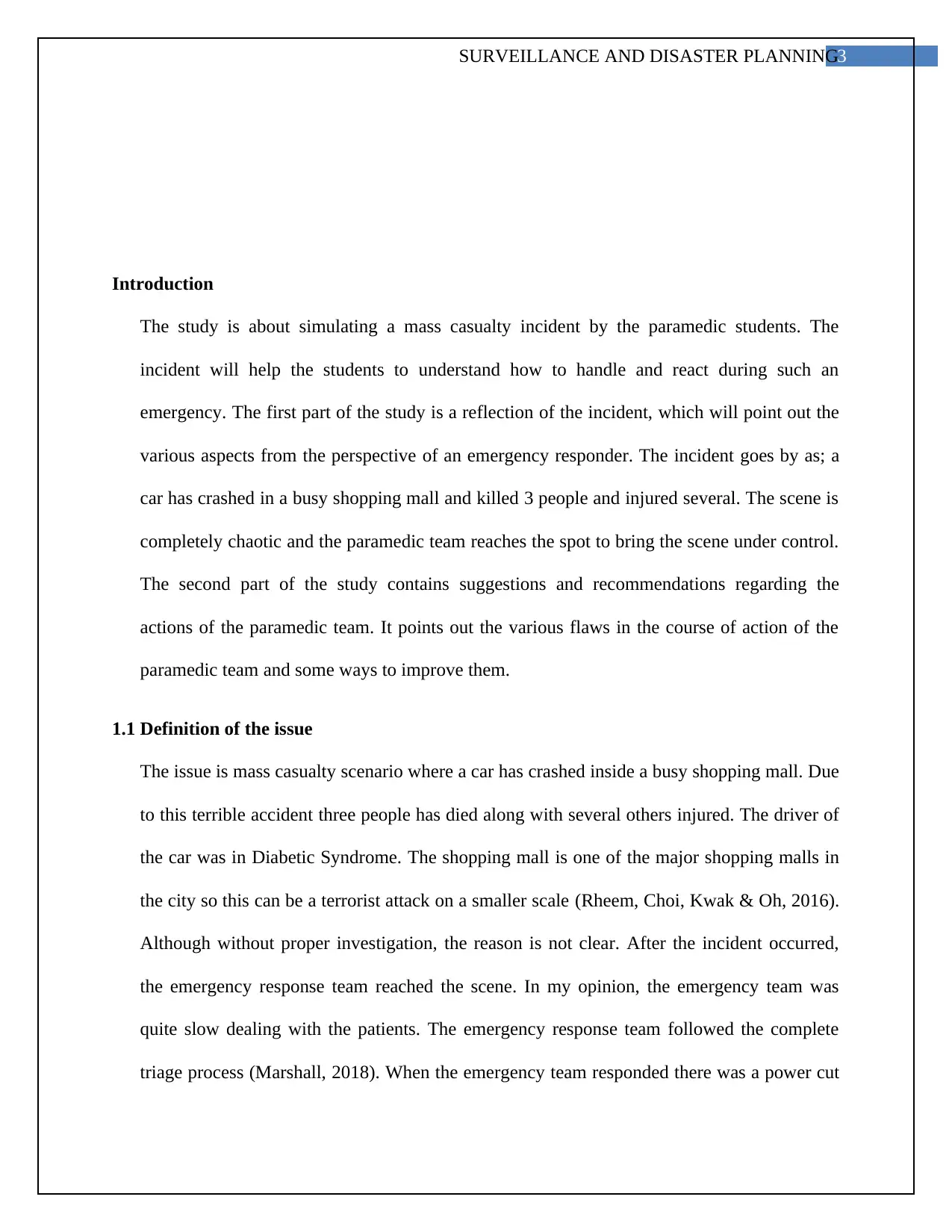
3SURVEILLANCE AND DISASTER PLANNING
Introduction
The study is about simulating a mass casualty incident by the paramedic students. The
incident will help the students to understand how to handle and react during such an
emergency. The first part of the study is a reflection of the incident, which will point out the
various aspects from the perspective of an emergency responder. The incident goes by as; a
car has crashed in a busy shopping mall and killed 3 people and injured several. The scene is
completely chaotic and the paramedic team reaches the spot to bring the scene under control.
The second part of the study contains suggestions and recommendations regarding the
actions of the paramedic team. It points out the various flaws in the course of action of the
paramedic team and some ways to improve them.
1.1 Definition of the issue
The issue is mass casualty scenario where a car has crashed inside a busy shopping mall. Due
to this terrible accident three people has died along with several others injured. The driver of
the car was in Diabetic Syndrome. The shopping mall is one of the major shopping malls in
the city so this can be a terrorist attack on a smaller scale (Rheem, Choi, Kwak & Oh, 2016).
Although without proper investigation, the reason is not clear. After the incident occurred,
the emergency response team reached the scene. In my opinion, the emergency team was
quite slow dealing with the patients. The emergency response team followed the complete
triage process (Marshall, 2018). When the emergency team responded there was a power cut
Introduction
The study is about simulating a mass casualty incident by the paramedic students. The
incident will help the students to understand how to handle and react during such an
emergency. The first part of the study is a reflection of the incident, which will point out the
various aspects from the perspective of an emergency responder. The incident goes by as; a
car has crashed in a busy shopping mall and killed 3 people and injured several. The scene is
completely chaotic and the paramedic team reaches the spot to bring the scene under control.
The second part of the study contains suggestions and recommendations regarding the
actions of the paramedic team. It points out the various flaws in the course of action of the
paramedic team and some ways to improve them.
1.1 Definition of the issue
The issue is mass casualty scenario where a car has crashed inside a busy shopping mall. Due
to this terrible accident three people has died along with several others injured. The driver of
the car was in Diabetic Syndrome. The shopping mall is one of the major shopping malls in
the city so this can be a terrorist attack on a smaller scale (Rheem, Choi, Kwak & Oh, 2016).
Although without proper investigation, the reason is not clear. After the incident occurred,
the emergency response team reached the scene. In my opinion, the emergency team was
quite slow dealing with the patients. The emergency response team followed the complete
triage process (Marshall, 2018). When the emergency team responded there was a power cut
Paraphrase This Document
Need a fresh take? Get an instant paraphrase of this document with our AI Paraphraser
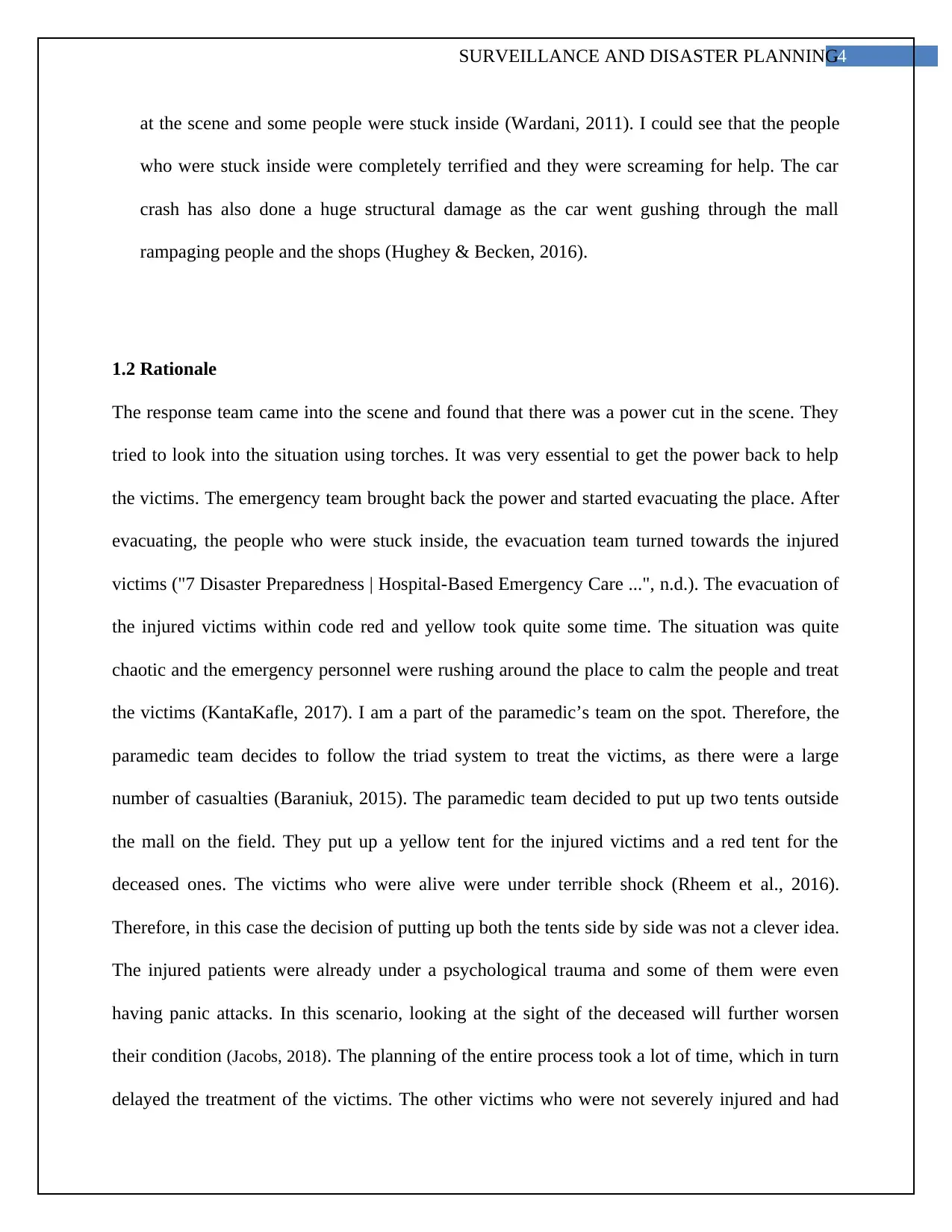
4SURVEILLANCE AND DISASTER PLANNING
at the scene and some people were stuck inside (Wardani, 2011). I could see that the people
who were stuck inside were completely terrified and they were screaming for help. The car
crash has also done a huge structural damage as the car went gushing through the mall
rampaging people and the shops (Hughey & Becken, 2016).
1.2 Rationale
The response team came into the scene and found that there was a power cut in the scene. They
tried to look into the situation using torches. It was very essential to get the power back to help
the victims. The emergency team brought back the power and started evacuating the place. After
evacuating, the people who were stuck inside, the evacuation team turned towards the injured
victims ("7 Disaster Preparedness | Hospital-Based Emergency Care ...", n.d.). The evacuation of
the injured victims within code red and yellow took quite some time. The situation was quite
chaotic and the emergency personnel were rushing around the place to calm the people and treat
the victims (KantaKafle, 2017). I am a part of the paramedic’s team on the spot. Therefore, the
paramedic team decides to follow the triad system to treat the victims, as there were a large
number of casualties (Baraniuk, 2015). The paramedic team decided to put up two tents outside
the mall on the field. They put up a yellow tent for the injured victims and a red tent for the
deceased ones. The victims who were alive were under terrible shock (Rheem et al., 2016).
Therefore, in this case the decision of putting up both the tents side by side was not a clever idea.
The injured patients were already under a psychological trauma and some of them were even
having panic attacks. In this scenario, looking at the sight of the deceased will further worsen
their condition (Jacobs, 2018). The planning of the entire process took a lot of time, which in turn
delayed the treatment of the victims. The other victims who were not severely injured and had
at the scene and some people were stuck inside (Wardani, 2011). I could see that the people
who were stuck inside were completely terrified and they were screaming for help. The car
crash has also done a huge structural damage as the car went gushing through the mall
rampaging people and the shops (Hughey & Becken, 2016).
1.2 Rationale
The response team came into the scene and found that there was a power cut in the scene. They
tried to look into the situation using torches. It was very essential to get the power back to help
the victims. The emergency team brought back the power and started evacuating the place. After
evacuating, the people who were stuck inside, the evacuation team turned towards the injured
victims ("7 Disaster Preparedness | Hospital-Based Emergency Care ...", n.d.). The evacuation of
the injured victims within code red and yellow took quite some time. The situation was quite
chaotic and the emergency personnel were rushing around the place to calm the people and treat
the victims (KantaKafle, 2017). I am a part of the paramedic’s team on the spot. Therefore, the
paramedic team decides to follow the triad system to treat the victims, as there were a large
number of casualties (Baraniuk, 2015). The paramedic team decided to put up two tents outside
the mall on the field. They put up a yellow tent for the injured victims and a red tent for the
deceased ones. The victims who were alive were under terrible shock (Rheem et al., 2016).
Therefore, in this case the decision of putting up both the tents side by side was not a clever idea.
The injured patients were already under a psychological trauma and some of them were even
having panic attacks. In this scenario, looking at the sight of the deceased will further worsen
their condition (Jacobs, 2018). The planning of the entire process took a lot of time, which in turn
delayed the treatment of the victims. The other victims who were not severely injured and had
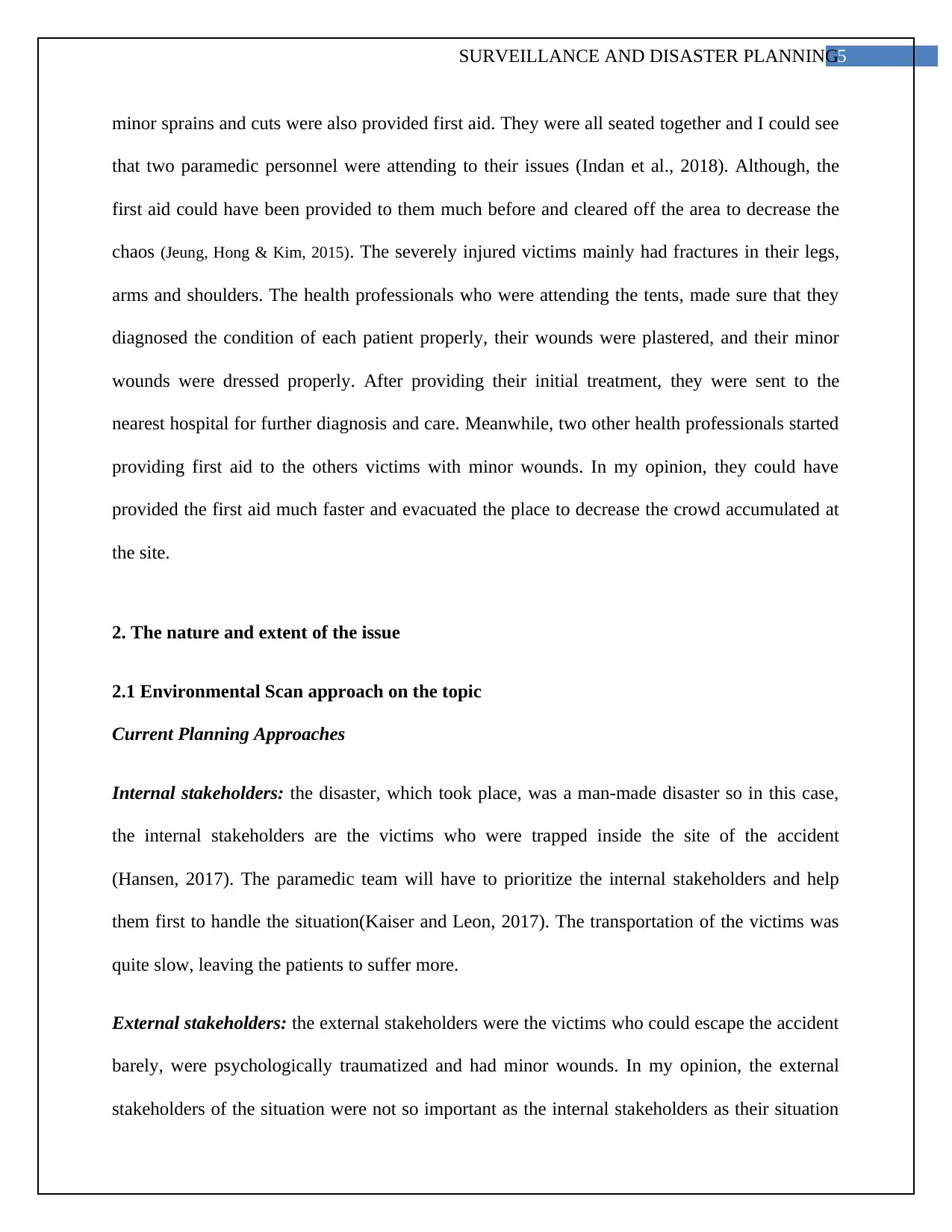
5SURVEILLANCE AND DISASTER PLANNING
minor sprains and cuts were also provided first aid. They were all seated together and I could see
that two paramedic personnel were attending to their issues (Indan et al., 2018). Although, the
first aid could have been provided to them much before and cleared off the area to decrease the
chaos (Jeung, Hong & Kim, 2015). The severely injured victims mainly had fractures in their legs,
arms and shoulders. The health professionals who were attending the tents, made sure that they
diagnosed the condition of each patient properly, their wounds were plastered, and their minor
wounds were dressed properly. After providing their initial treatment, they were sent to the
nearest hospital for further diagnosis and care. Meanwhile, two other health professionals started
providing first aid to the others victims with minor wounds. In my opinion, they could have
provided the first aid much faster and evacuated the place to decrease the crowd accumulated at
the site.
2. The nature and extent of the issue
2.1 Environmental Scan approach on the topic
Current Planning Approaches
Internal stakeholders: the disaster, which took place, was a man-made disaster so in this case,
the internal stakeholders are the victims who were trapped inside the site of the accident
(Hansen, 2017). The paramedic team will have to prioritize the internal stakeholders and help
them first to handle the situation(Kaiser and Leon, 2017). The transportation of the victims was
quite slow, leaving the patients to suffer more.
External stakeholders: the external stakeholders were the victims who could escape the accident
barely, were psychologically traumatized and had minor wounds. In my opinion, the external
stakeholders of the situation were not so important as the internal stakeholders as their situation
minor sprains and cuts were also provided first aid. They were all seated together and I could see
that two paramedic personnel were attending to their issues (Indan et al., 2018). Although, the
first aid could have been provided to them much before and cleared off the area to decrease the
chaos (Jeung, Hong & Kim, 2015). The severely injured victims mainly had fractures in their legs,
arms and shoulders. The health professionals who were attending the tents, made sure that they
diagnosed the condition of each patient properly, their wounds were plastered, and their minor
wounds were dressed properly. After providing their initial treatment, they were sent to the
nearest hospital for further diagnosis and care. Meanwhile, two other health professionals started
providing first aid to the others victims with minor wounds. In my opinion, they could have
provided the first aid much faster and evacuated the place to decrease the crowd accumulated at
the site.
2. The nature and extent of the issue
2.1 Environmental Scan approach on the topic
Current Planning Approaches
Internal stakeholders: the disaster, which took place, was a man-made disaster so in this case,
the internal stakeholders are the victims who were trapped inside the site of the accident
(Hansen, 2017). The paramedic team will have to prioritize the internal stakeholders and help
them first to handle the situation(Kaiser and Leon, 2017). The transportation of the victims was
quite slow, leaving the patients to suffer more.
External stakeholders: the external stakeholders were the victims who could escape the accident
barely, were psychologically traumatized and had minor wounds. In my opinion, the external
stakeholders of the situation were not so important as the internal stakeholders as their situation
⊘ This is a preview!⊘
Do you want full access?
Subscribe today to unlock all pages.

Trusted by 1+ million students worldwide
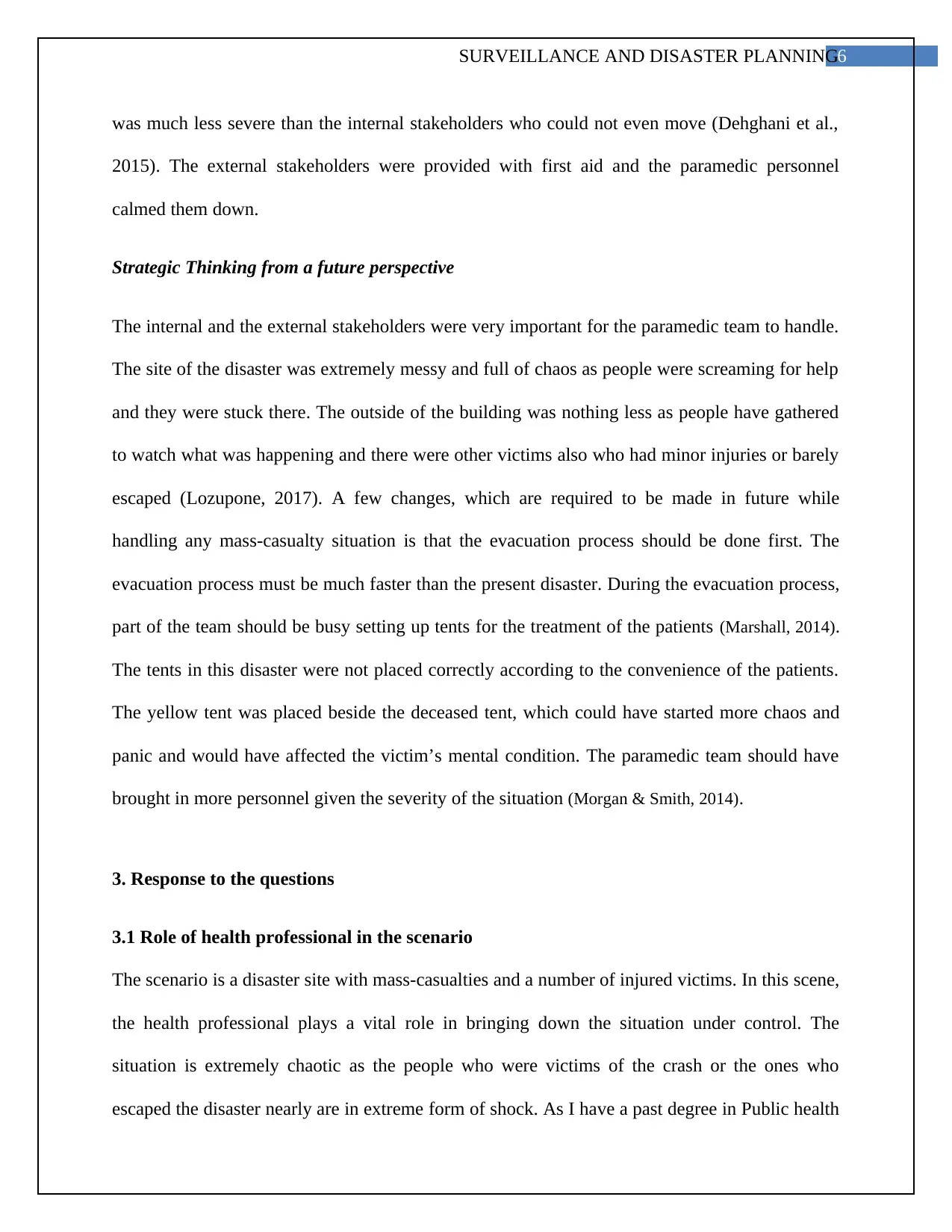
6SURVEILLANCE AND DISASTER PLANNING
was much less severe than the internal stakeholders who could not even move (Dehghani et al.,
2015). The external stakeholders were provided with first aid and the paramedic personnel
calmed them down.
Strategic Thinking from a future perspective
The internal and the external stakeholders were very important for the paramedic team to handle.
The site of the disaster was extremely messy and full of chaos as people were screaming for help
and they were stuck there. The outside of the building was nothing less as people have gathered
to watch what was happening and there were other victims also who had minor injuries or barely
escaped (Lozupone, 2017). A few changes, which are required to be made in future while
handling any mass-casualty situation is that the evacuation process should be done first. The
evacuation process must be much faster than the present disaster. During the evacuation process,
part of the team should be busy setting up tents for the treatment of the patients (Marshall, 2014).
The tents in this disaster were not placed correctly according to the convenience of the patients.
The yellow tent was placed beside the deceased tent, which could have started more chaos and
panic and would have affected the victim’s mental condition. The paramedic team should have
brought in more personnel given the severity of the situation (Morgan & Smith, 2014).
3. Response to the questions
3.1 Role of health professional in the scenario
The scenario is a disaster site with mass-casualties and a number of injured victims. In this scene,
the health professional plays a vital role in bringing down the situation under control. The
situation is extremely chaotic as the people who were victims of the crash or the ones who
escaped the disaster nearly are in extreme form of shock. As I have a past degree in Public health
was much less severe than the internal stakeholders who could not even move (Dehghani et al.,
2015). The external stakeholders were provided with first aid and the paramedic personnel
calmed them down.
Strategic Thinking from a future perspective
The internal and the external stakeholders were very important for the paramedic team to handle.
The site of the disaster was extremely messy and full of chaos as people were screaming for help
and they were stuck there. The outside of the building was nothing less as people have gathered
to watch what was happening and there were other victims also who had minor injuries or barely
escaped (Lozupone, 2017). A few changes, which are required to be made in future while
handling any mass-casualty situation is that the evacuation process should be done first. The
evacuation process must be much faster than the present disaster. During the evacuation process,
part of the team should be busy setting up tents for the treatment of the patients (Marshall, 2014).
The tents in this disaster were not placed correctly according to the convenience of the patients.
The yellow tent was placed beside the deceased tent, which could have started more chaos and
panic and would have affected the victim’s mental condition. The paramedic team should have
brought in more personnel given the severity of the situation (Morgan & Smith, 2014).
3. Response to the questions
3.1 Role of health professional in the scenario
The scenario is a disaster site with mass-casualties and a number of injured victims. In this scene,
the health professional plays a vital role in bringing down the situation under control. The
situation is extremely chaotic as the people who were victims of the crash or the ones who
escaped the disaster nearly are in extreme form of shock. As I have a past degree in Public health
Paraphrase This Document
Need a fresh take? Get an instant paraphrase of this document with our AI Paraphraser

7SURVEILLANCE AND DISASTER PLANNING
along with a good knowledge in pharmacy, I can be helpful for the paramedic team. The car
crashed inside a busy shopping mall killing three people and heavily injuring eight others. The
condition of the eight patients is quite severe and their diagnosis is unknown (А.D, 2015). My
first job as a health professional is to securely transport the patients from the disaster site to the
tents outside. With the help of some of my other colleagues, I transported the victims one by one
on stretcher to the yellow tent. After the transportation process, the victims were calmed first by
the medical professionals and then the victims were thoroughly examined for fractures or any
other internal damage (Farra, Smith &Bashaw, 2016). The eight victims mainly had fracture
issues in hands, shoulder and legs. Therefore, for an instant relief their fractures were plastered
and they were given some morphine to ease their pain (Rheem, Choi, Kwak& Oh, 2016). After
the initial treatment by the paramedic team, they were sent to the nearest hospital for further
checkups and treatment. The victims were shell-shocked so they were also recommended
counselors to overcome their mental trauma (Farra & Bashaw, 2016).
3.2 Response of the professional
During the occurrence of the disaster, the response of the health professionals should be quick
and accurate to measure the vulnerability. The scenario should be analyzed properly by the
health professionals . Main focus should be given to the individuals who have maximum injuries
from the disaster (Kaiser & Leon, 2017). It is important to response according to the demand of
the situation (Du et al., 2015).The health professionals and the rescue professional should work
in a coordinated way according to the disaster management plan along with a few modifications
as per the situation (Baraniuk, 2015). The health professionals in the scenario were not quick
enough in their evacuation process. When they reached the disaster site, they should be tried
along with a good knowledge in pharmacy, I can be helpful for the paramedic team. The car
crashed inside a busy shopping mall killing three people and heavily injuring eight others. The
condition of the eight patients is quite severe and their diagnosis is unknown (А.D, 2015). My
first job as a health professional is to securely transport the patients from the disaster site to the
tents outside. With the help of some of my other colleagues, I transported the victims one by one
on stretcher to the yellow tent. After the transportation process, the victims were calmed first by
the medical professionals and then the victims were thoroughly examined for fractures or any
other internal damage (Farra, Smith &Bashaw, 2016). The eight victims mainly had fracture
issues in hands, shoulder and legs. Therefore, for an instant relief their fractures were plastered
and they were given some morphine to ease their pain (Rheem, Choi, Kwak& Oh, 2016). After
the initial treatment by the paramedic team, they were sent to the nearest hospital for further
checkups and treatment. The victims were shell-shocked so they were also recommended
counselors to overcome their mental trauma (Farra & Bashaw, 2016).
3.2 Response of the professional
During the occurrence of the disaster, the response of the health professionals should be quick
and accurate to measure the vulnerability. The scenario should be analyzed properly by the
health professionals . Main focus should be given to the individuals who have maximum injuries
from the disaster (Kaiser & Leon, 2017). It is important to response according to the demand of
the situation (Du et al., 2015).The health professionals and the rescue professional should work
in a coordinated way according to the disaster management plan along with a few modifications
as per the situation (Baraniuk, 2015). The health professionals in the scenario were not quick
enough in their evacuation process. When they reached the disaster site, they should be tried
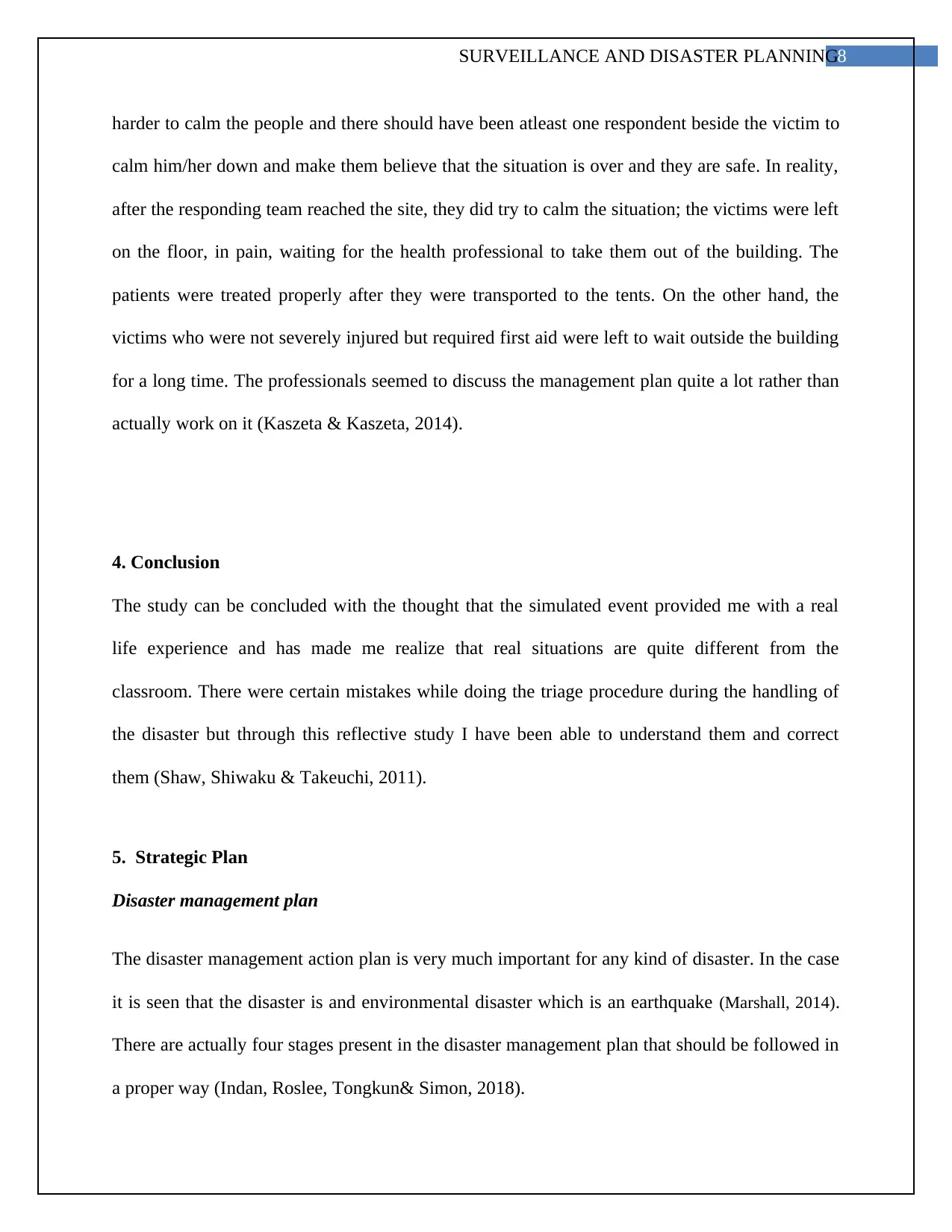
8SURVEILLANCE AND DISASTER PLANNING
harder to calm the people and there should have been atleast one respondent beside the victim to
calm him/her down and make them believe that the situation is over and they are safe. In reality,
after the responding team reached the site, they did try to calm the situation; the victims were left
on the floor, in pain, waiting for the health professional to take them out of the building. The
patients were treated properly after they were transported to the tents. On the other hand, the
victims who were not severely injured but required first aid were left to wait outside the building
for a long time. The professionals seemed to discuss the management plan quite a lot rather than
actually work on it (Kaszeta & Kaszeta, 2014).
4. Conclusion
The study can be concluded with the thought that the simulated event provided me with a real
life experience and has made me realize that real situations are quite different from the
classroom. There were certain mistakes while doing the triage procedure during the handling of
the disaster but through this reflective study I have been able to understand them and correct
them (Shaw, Shiwaku & Takeuchi, 2011).
5. Strategic Plan
Disaster management plan
The disaster management action plan is very much important for any kind of disaster. In the case
it is seen that the disaster is and environmental disaster which is an earthquake (Marshall, 2014).
There are actually four stages present in the disaster management plan that should be followed in
a proper way (Indan, Roslee, Tongkun& Simon, 2018).
harder to calm the people and there should have been atleast one respondent beside the victim to
calm him/her down and make them believe that the situation is over and they are safe. In reality,
after the responding team reached the site, they did try to calm the situation; the victims were left
on the floor, in pain, waiting for the health professional to take them out of the building. The
patients were treated properly after they were transported to the tents. On the other hand, the
victims who were not severely injured but required first aid were left to wait outside the building
for a long time. The professionals seemed to discuss the management plan quite a lot rather than
actually work on it (Kaszeta & Kaszeta, 2014).
4. Conclusion
The study can be concluded with the thought that the simulated event provided me with a real
life experience and has made me realize that real situations are quite different from the
classroom. There were certain mistakes while doing the triage procedure during the handling of
the disaster but through this reflective study I have been able to understand them and correct
them (Shaw, Shiwaku & Takeuchi, 2011).
5. Strategic Plan
Disaster management plan
The disaster management action plan is very much important for any kind of disaster. In the case
it is seen that the disaster is and environmental disaster which is an earthquake (Marshall, 2014).
There are actually four stages present in the disaster management plan that should be followed in
a proper way (Indan, Roslee, Tongkun& Simon, 2018).
⊘ This is a preview!⊘
Do you want full access?
Subscribe today to unlock all pages.

Trusted by 1+ million students worldwide
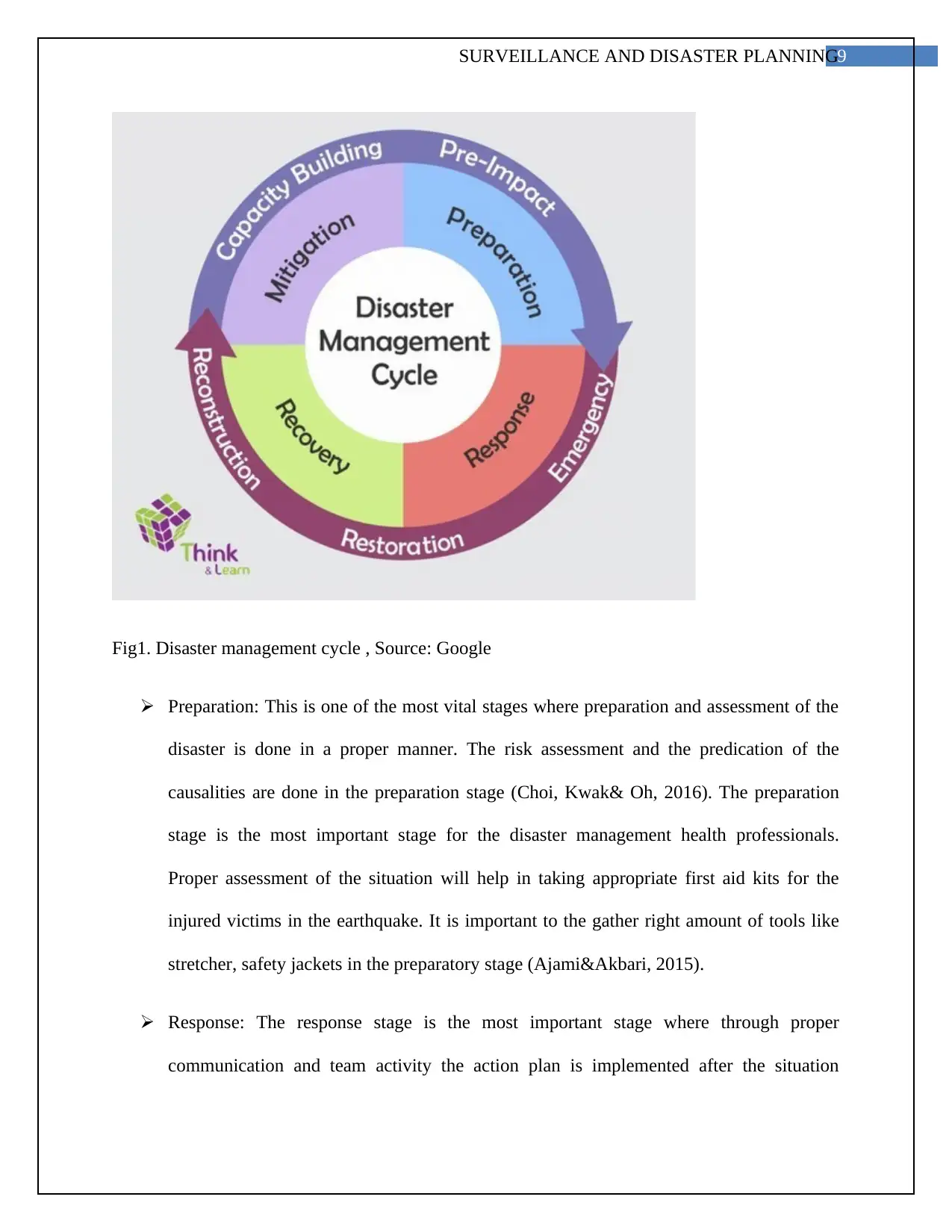
9SURVEILLANCE AND DISASTER PLANNING
Fig1. Disaster management cycle , Source: Google
Preparation: This is one of the most vital stages where preparation and assessment of the
disaster is done in a proper manner. The risk assessment and the predication of the
causalities are done in the preparation stage (Choi, Kwak& Oh, 2016). The preparation
stage is the most important stage for the disaster management health professionals.
Proper assessment of the situation will help in taking appropriate first aid kits for the
injured victims in the earthquake. It is important to the gather right amount of tools like
stretcher, safety jackets in the preparatory stage (Ajami&Akbari, 2015).
Response: The response stage is the most important stage where through proper
communication and team activity the action plan is implemented after the situation
Fig1. Disaster management cycle , Source: Google
Preparation: This is one of the most vital stages where preparation and assessment of the
disaster is done in a proper manner. The risk assessment and the predication of the
causalities are done in the preparation stage (Choi, Kwak& Oh, 2016). The preparation
stage is the most important stage for the disaster management health professionals.
Proper assessment of the situation will help in taking appropriate first aid kits for the
injured victims in the earthquake. It is important to the gather right amount of tools like
stretcher, safety jackets in the preparatory stage (Ajami&Akbari, 2015).
Response: The response stage is the most important stage where through proper
communication and team activity the action plan is implemented after the situation
Paraphrase This Document
Need a fresh take? Get an instant paraphrase of this document with our AI Paraphraser
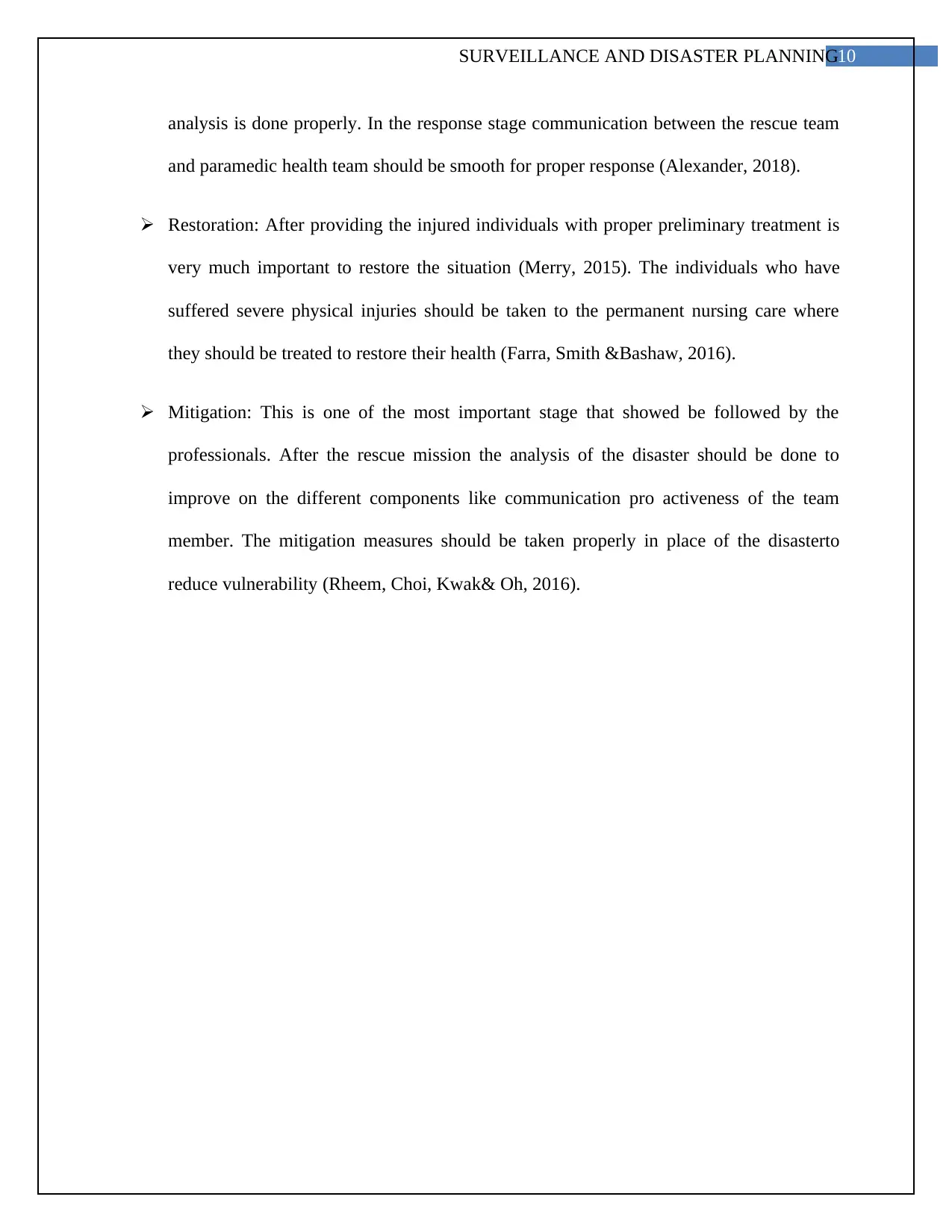
10SURVEILLANCE AND DISASTER PLANNING
analysis is done properly. In the response stage communication between the rescue team
and paramedic health team should be smooth for proper response (Alexander, 2018).
Restoration: After providing the injured individuals with proper preliminary treatment is
very much important to restore the situation (Merry, 2015). The individuals who have
suffered severe physical injuries should be taken to the permanent nursing care where
they should be treated to restore their health (Farra, Smith &Bashaw, 2016).
Mitigation: This is one of the most important stage that showed be followed by the
professionals. After the rescue mission the analysis of the disaster should be done to
improve on the different components like communication pro activeness of the team
member. The mitigation measures should be taken properly in place of the disasterto
reduce vulnerability (Rheem, Choi, Kwak& Oh, 2016).
analysis is done properly. In the response stage communication between the rescue team
and paramedic health team should be smooth for proper response (Alexander, 2018).
Restoration: After providing the injured individuals with proper preliminary treatment is
very much important to restore the situation (Merry, 2015). The individuals who have
suffered severe physical injuries should be taken to the permanent nursing care where
they should be treated to restore their health (Farra, Smith &Bashaw, 2016).
Mitigation: This is one of the most important stage that showed be followed by the
professionals. After the rescue mission the analysis of the disaster should be done to
improve on the different components like communication pro activeness of the team
member. The mitigation measures should be taken properly in place of the disasterto
reduce vulnerability (Rheem, Choi, Kwak& Oh, 2016).
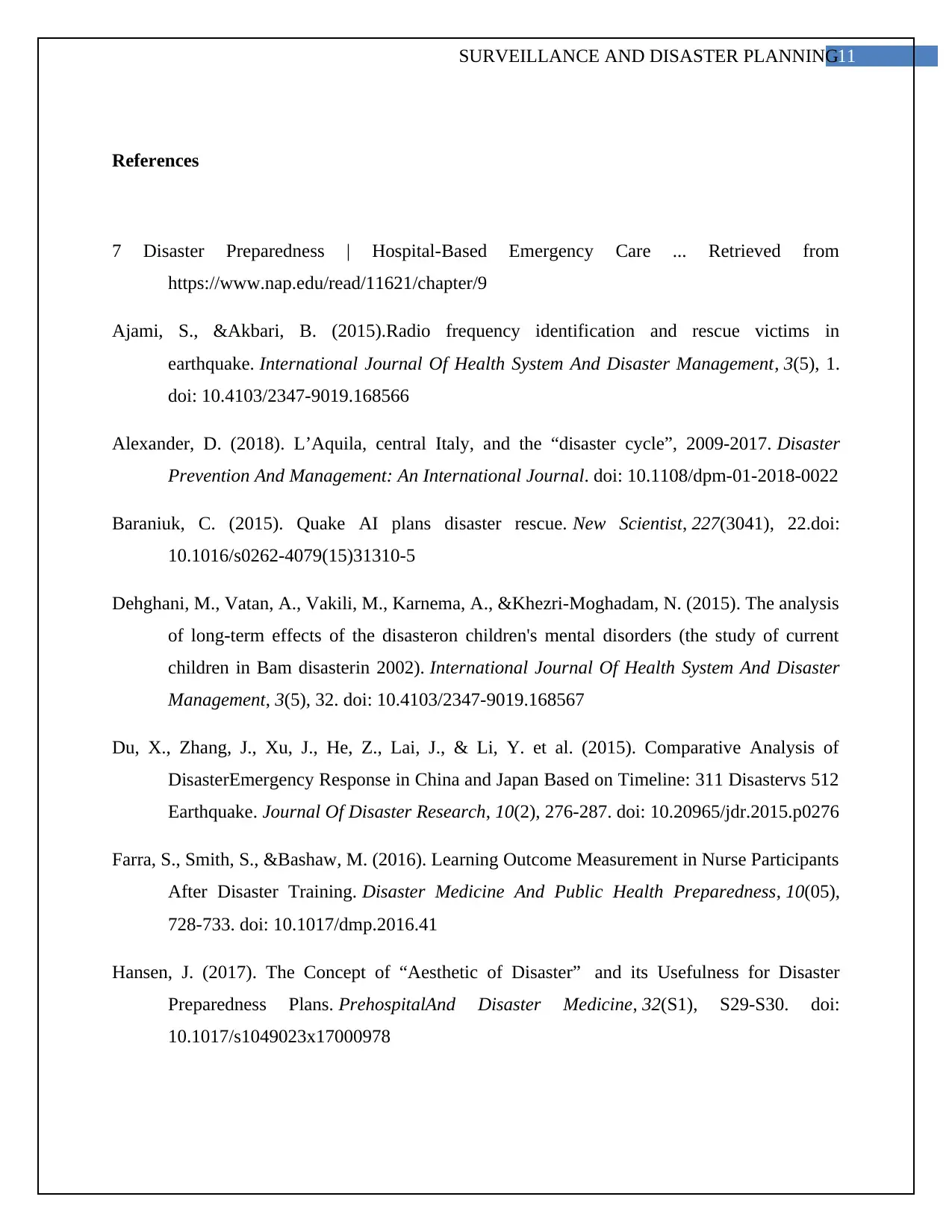
11SURVEILLANCE AND DISASTER PLANNING
References
7 Disaster Preparedness | Hospital-Based Emergency Care ... Retrieved from
https://www.nap.edu/read/11621/chapter/9
Ajami, S., &Akbari, B. (2015).Radio frequency identification and rescue victims in
earthquake. International Journal Of Health System And Disaster Management, 3(5), 1.
doi: 10.4103/2347-9019.168566
Alexander, D. (2018). L’Aquila, central Italy, and the “disaster cycle”, 2009-2017. Disaster
Prevention And Management: An International Journal. doi: 10.1108/dpm-01-2018-0022
Baraniuk, C. (2015). Quake AI plans disaster rescue. New Scientist, 227(3041), 22.doi:
10.1016/s0262-4079(15)31310-5
Dehghani, M., Vatan, A., Vakili, M., Karnema, A., &Khezri-Moghadam, N. (2015). The analysis
of long-term effects of the disasteron children's mental disorders (the study of current
children in Bam disasterin 2002). International Journal Of Health System And Disaster
Management, 3(5), 32. doi: 10.4103/2347-9019.168567
Du, X., Zhang, J., Xu, J., He, Z., Lai, J., & Li, Y. et al. (2015). Comparative Analysis of
DisasterEmergency Response in China and Japan Based on Timeline: 311 Disastervs 512
Earthquake. Journal Of Disaster Research, 10(2), 276-287. doi: 10.20965/jdr.2015.p0276
Farra, S., Smith, S., &Bashaw, M. (2016). Learning Outcome Measurement in Nurse Participants
After Disaster Training. Disaster Medicine And Public Health Preparedness, 10(05),
728-733. doi: 10.1017/dmp.2016.41
Hansen, J. (2017). The Concept of “Aesthetic of Disaster” and its Usefulness for Disaster
Preparedness Plans. PrehospitalAnd Disaster Medicine, 32(S1), S29-S30. doi:
10.1017/s1049023x17000978
References
7 Disaster Preparedness | Hospital-Based Emergency Care ... Retrieved from
https://www.nap.edu/read/11621/chapter/9
Ajami, S., &Akbari, B. (2015).Radio frequency identification and rescue victims in
earthquake. International Journal Of Health System And Disaster Management, 3(5), 1.
doi: 10.4103/2347-9019.168566
Alexander, D. (2018). L’Aquila, central Italy, and the “disaster cycle”, 2009-2017. Disaster
Prevention And Management: An International Journal. doi: 10.1108/dpm-01-2018-0022
Baraniuk, C. (2015). Quake AI plans disaster rescue. New Scientist, 227(3041), 22.doi:
10.1016/s0262-4079(15)31310-5
Dehghani, M., Vatan, A., Vakili, M., Karnema, A., &Khezri-Moghadam, N. (2015). The analysis
of long-term effects of the disasteron children's mental disorders (the study of current
children in Bam disasterin 2002). International Journal Of Health System And Disaster
Management, 3(5), 32. doi: 10.4103/2347-9019.168567
Du, X., Zhang, J., Xu, J., He, Z., Lai, J., & Li, Y. et al. (2015). Comparative Analysis of
DisasterEmergency Response in China and Japan Based on Timeline: 311 Disastervs 512
Earthquake. Journal Of Disaster Research, 10(2), 276-287. doi: 10.20965/jdr.2015.p0276
Farra, S., Smith, S., &Bashaw, M. (2016). Learning Outcome Measurement in Nurse Participants
After Disaster Training. Disaster Medicine And Public Health Preparedness, 10(05),
728-733. doi: 10.1017/dmp.2016.41
Hansen, J. (2017). The Concept of “Aesthetic of Disaster” and its Usefulness for Disaster
Preparedness Plans. PrehospitalAnd Disaster Medicine, 32(S1), S29-S30. doi:
10.1017/s1049023x17000978
⊘ This is a preview!⊘
Do you want full access?
Subscribe today to unlock all pages.

Trusted by 1+ million students worldwide

12SURVEILLANCE AND DISASTER PLANNING
Hughey, K., & Becken, S. (2016). Value-engaged evaluation of a tourism-specific disaster
management plan. Tourism Management Perspectives, 19, 69-73. doi:
10.1016/j.tmp.2016.03.003
Indan, E., Roslee, R., Tongkul, F., & Simon, N. (2018). DISASTERVULNERABILITY
ASSESSMENT (EVAS): ANALYSIS OF ENVIRONMENTAL VULNERABILITY
AND SOCIAL VULNERABILITY IN RANAU AREA, SABAH,
MALAYSIA. Geological Behavior, 2(1), 24-28. doi: 10.26480/gbr.01.2018.24.28
Jacobs, F. (2018). Black feminism and radical planning: New directions for disaster planning
research. Planning Theory, 147309521876322. doi: 10.1177/1473095218763221
Jeung, S., Hong, I., & Kim, B. (2015). Non-stationary Intensity-Duration-Frequency Curves &
Design Flood for Drainage System Design Coping with Climate Change. Crisis And
Emergency Management, 11(10), 237-255. doi: 10.14251/krcem.2015.11.10.237
Kaiser, C., & Leon, R. (2017).Designing a County-wide Crisis Care Plan. PrehospitalAnd
Disaster Medicine, 32(S1), S195-S196. doi: 10.1017/s1049023x1700512x
KantaKafle, S. (2017). Disaster Risk Management Systems in South Asia: Natural Hazards,
Vulnerability, Disaster Risk and Legislative and Institutional Frameworks. Journal Of
Geography & Natural Disasters, 7(3). doi: 10.4172/2167-0587.1000207
Kaszeta, D., & Kaszeta, D. (2014). CBRN and Hazmat Incidents at Major Public Events.
Somerset: Wiley.
Lozupone, V. (2017). Disaster recovery plan for medical records company. International Journal
Of Information Management, 37(6), 622-626. doi: 10.1016/j.ijinfomgt.2017.05.015
Marshall, A. (2014). The role of the health information professional. Health Information &
Libraries Journal, 34(4), 293-295. doi: 10.1111/hir.12077
Marshall, D. (2018). An Overview of the California DisasterAuthority. Risk Management And
Insurance Review, 21(1), 73-116. doi: 10.1111/rmir.12097
Hughey, K., & Becken, S. (2016). Value-engaged evaluation of a tourism-specific disaster
management plan. Tourism Management Perspectives, 19, 69-73. doi:
10.1016/j.tmp.2016.03.003
Indan, E., Roslee, R., Tongkul, F., & Simon, N. (2018). DISASTERVULNERABILITY
ASSESSMENT (EVAS): ANALYSIS OF ENVIRONMENTAL VULNERABILITY
AND SOCIAL VULNERABILITY IN RANAU AREA, SABAH,
MALAYSIA. Geological Behavior, 2(1), 24-28. doi: 10.26480/gbr.01.2018.24.28
Jacobs, F. (2018). Black feminism and radical planning: New directions for disaster planning
research. Planning Theory, 147309521876322. doi: 10.1177/1473095218763221
Jeung, S., Hong, I., & Kim, B. (2015). Non-stationary Intensity-Duration-Frequency Curves &
Design Flood for Drainage System Design Coping with Climate Change. Crisis And
Emergency Management, 11(10), 237-255. doi: 10.14251/krcem.2015.11.10.237
Kaiser, C., & Leon, R. (2017).Designing a County-wide Crisis Care Plan. PrehospitalAnd
Disaster Medicine, 32(S1), S195-S196. doi: 10.1017/s1049023x1700512x
KantaKafle, S. (2017). Disaster Risk Management Systems in South Asia: Natural Hazards,
Vulnerability, Disaster Risk and Legislative and Institutional Frameworks. Journal Of
Geography & Natural Disasters, 7(3). doi: 10.4172/2167-0587.1000207
Kaszeta, D., & Kaszeta, D. (2014). CBRN and Hazmat Incidents at Major Public Events.
Somerset: Wiley.
Lozupone, V. (2017). Disaster recovery plan for medical records company. International Journal
Of Information Management, 37(6), 622-626. doi: 10.1016/j.ijinfomgt.2017.05.015
Marshall, A. (2014). The role of the health information professional. Health Information &
Libraries Journal, 34(4), 293-295. doi: 10.1111/hir.12077
Marshall, D. (2018). An Overview of the California DisasterAuthority. Risk Management And
Insurance Review, 21(1), 73-116. doi: 10.1111/rmir.12097
Paraphrase This Document
Need a fresh take? Get an instant paraphrase of this document with our AI Paraphraser
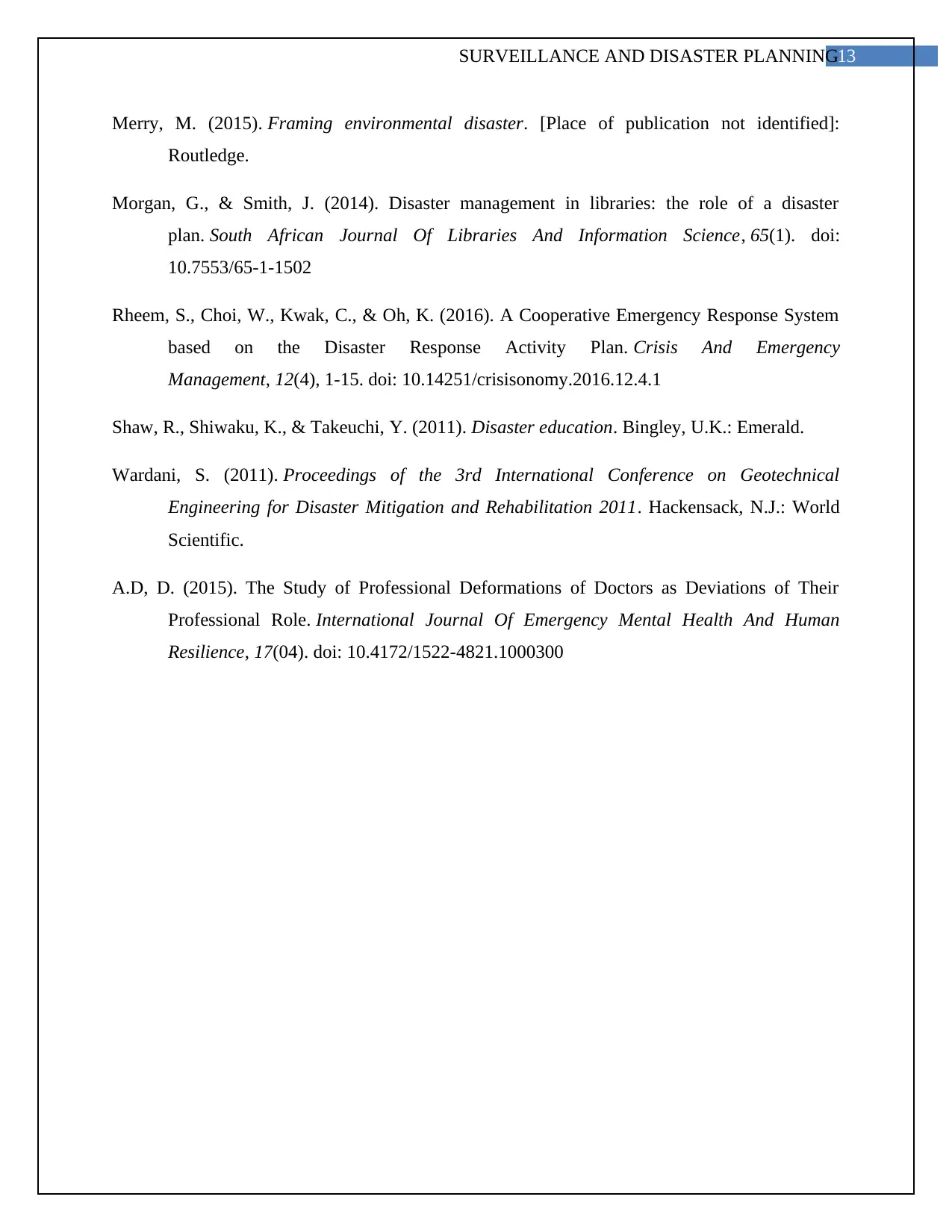
13SURVEILLANCE AND DISASTER PLANNING
Merry, M. (2015). Framing environmental disaster. [Place of publication not identified]:
Routledge.
Morgan, G., & Smith, J. (2014). Disaster management in libraries: the role of a disaster
plan. South African Journal Of Libraries And Information Science, 65(1). doi:
10.7553/65-1-1502
Rheem, S., Choi, W., Kwak, C., & Oh, K. (2016). A Cooperative Emergency Response System
based on the Disaster Response Activity Plan. Crisis And Emergency
Management, 12(4), 1-15. doi: 10.14251/crisisonomy.2016.12.4.1
Shaw, R., Shiwaku, K., & Takeuchi, Y. (2011). Disaster education. Bingley, U.K.: Emerald.
Wardani, S. (2011). Proceedings of the 3rd International Conference on Geotechnical
Engineering for Disaster Mitigation and Rehabilitation 2011. Hackensack, N.J.: World
Scientific.
А.D, D. (2015). The Study of Professional Deformations of Doctors as Deviations of Their
Professional Role. International Journal Of Emergency Mental Health And Human
Resilience, 17(04). doi: 10.4172/1522-4821.1000300
Merry, M. (2015). Framing environmental disaster. [Place of publication not identified]:
Routledge.
Morgan, G., & Smith, J. (2014). Disaster management in libraries: the role of a disaster
plan. South African Journal Of Libraries And Information Science, 65(1). doi:
10.7553/65-1-1502
Rheem, S., Choi, W., Kwak, C., & Oh, K. (2016). A Cooperative Emergency Response System
based on the Disaster Response Activity Plan. Crisis And Emergency
Management, 12(4), 1-15. doi: 10.14251/crisisonomy.2016.12.4.1
Shaw, R., Shiwaku, K., & Takeuchi, Y. (2011). Disaster education. Bingley, U.K.: Emerald.
Wardani, S. (2011). Proceedings of the 3rd International Conference on Geotechnical
Engineering for Disaster Mitigation and Rehabilitation 2011. Hackensack, N.J.: World
Scientific.
А.D, D. (2015). The Study of Professional Deformations of Doctors as Deviations of Their
Professional Role. International Journal Of Emergency Mental Health And Human
Resilience, 17(04). doi: 10.4172/1522-4821.1000300
1 out of 14
Related Documents
Your All-in-One AI-Powered Toolkit for Academic Success.
+13062052269
info@desklib.com
Available 24*7 on WhatsApp / Email
![[object Object]](/_next/static/media/star-bottom.7253800d.svg)
Unlock your academic potential
© 2024 | Zucol Services PVT LTD | All rights reserved.



